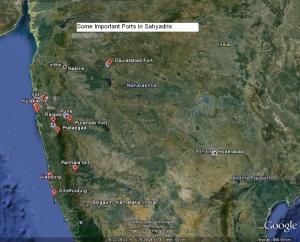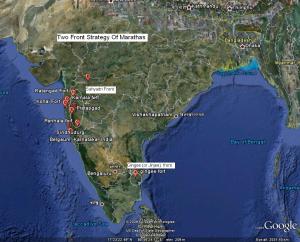27 Years War TimeLine – Marathas under King Rajaram (1689 to 1700)
This positive development was followed by a negative one for Marathas. Raigad fell to treachery of Suryaji Pisal. Sambhaji's queen, Yesubai and their son, Shahu, were captured.
Mughal forces, led by Zulfikar Khan, continued this offensive further South. They attacked fort Panhala. The Maratha killedar of Panhala gallantly defended the fort and inflicted heavy losses on Mughal army. Finally Aurangzeb himself had to come. Panhala surrendered.
Maratha ministers had foreseen the next Mughal move on Vishalgad. They made Rajaram leave Vishalgad for Jinji, which would be his home for next seven years. Rajaram travelled South under escort of Khando Ballal and his men. The queen of Bidnur, gave them supplies and free passage. Harji Mahadik's division met them near Jinji and guarded them to the fort. Rajaram's queen was escorted out of Maharashtra by Tungare brothers. She was taken to Jinji by different route. Ballal and Mahadik tirelessly worked to gather the scattered diplomats and soldiers. Jinji became new capital of Marathas. This breathed new life in Maratha army.
Aurangzeb was frustrated with Rajaram's successful escape. His next move was to keep most of his force in Maharashtra and dispatch a small force to keep Rajaram in check. But the two Maratha generals, Santaji ghorpade and Dhanaji Jadhav would prove more than match to him.
They first attacked and destroyed the force sent by Aurangzeb to keep check on Rajaram, thus relieving the immediate danger. Then they joined Ramchandra Bavadekar in Deccan. Bavdekar, Vithoji Bhosale and Raghuji Chavan had reorganized most of the Maratha army after defeats at Panhala and Vishalgad.
In late 1691, Bavdekar, Pralhad Niraji , Santaji ,Dhanaji and several Maratha sardars met in Maval region and reformed the strategy. Aurangzeb had taken four major forts in Sahyadrais and was sending Zulfikar khan to subdue the fort Jinji. So according to new Maratha plan, Santaji and Dhanaji would launch offensives in the East to keep rest of the Mughal forces scattered. Others would focus in Maharashtra and would attack a series of forts around Southern Maharashtra and Northern Karnataka to divide Mughal won territories in two, thereby posing significant challenge to enemy supply chains. Thanks to Shivaji's vision of building a navy, Marathas could now extend this divide into the sea, checking any supply routes from Surat to South.
The execution began. In early 1692 Shankar Narayan and Parshuram Trimbak recaptured Rajgad and Panhala. In early 1693 Shankar Narayan and Bhosale captured Rohida. Sidhoji Gujar took Vijaydurg. Soon Parshuram Trimbak took Vishalgad. Kanhoji Angre, a young Maratha Naval officer that time, took fort Kolaba.
While this was in work, Santaji and Dhanaji were launching swift raids on Mughal armies on East front. This came as a bit of surprise to Aurangzeb. In spite of losing one King and having second king driven away, Marathas were undaunted and actually were on offensive. From Khandesh, Ahmednagar to Bijapur to Konkan and Southern Karnataka, Santaji and Dhanaji wrecked havoc. Encouraged by the success, Santaji and Dhanaji hatched new action plan to attack Mughal forces near Jinji. Dhanaji Jadhav attacked Ismail Khan and defeated him near Kokar. Santaji Ghorpade attacked Ali Mardan Khan at the base of Jinji and captured him. With flanks cleared, both joined hands and laid a second siege around the Mughal siege at Jinji.
Julfikar khan, who was orchestrating Jinji siege, left the siege on Aurangzeb's orders and marched back. Santaji followed him to North, but was defeated by Julfikar Khan. Santaji then diverted his forces to Bijapur. Aurangzeb sent another general Kasim Khan to tackle Santaji. But Santaji attacked him with a brilliant military maneuver near Chitaldurg and forced him take refuge in Dunderi fort. The fort was quickly sieged by Santaji and the siege only ended when most of the Mughal soldiers starved and Kasim Khan committed suicide. Aurangzeb sent Himmat Khan to reinforce Kasim Khan. Himmat khan carried heavy artillery. So Santaji lured him in a trap in the forest near Dunderi. A sudden, ambush style attack on Mughals was followed by a fierce battle. The battle ended when when Himmat Khan was shot in head and died. All his forces routed and Santaji confiscated a big cache of weapons and ammunition.
By now, Aurangzeb had the grim realization that the war he began was much more serious than he thought. He consolidated his forces and rethought his strategy. He sent an ultimatum to Zulfikar khan to finish Jinji business or be stripped of the titles. Julfikar khan tightened the Siege. But Rajaram fled and was safely escorted to Deccan by Dhanaji Jadhav and Shirke brothers. Haraji Mahadik's son took the charge of Jinji and bravely defended Jinji against Julfikar khan and Daud khan till January of 1698. This gave Rajaram ample of time to reach Vishalgad.
Jinji fell, but it did a big damage to the Mughal empire. The losses incurred in taking Jinji far outweighed the gains. The fort had done its work. For seven years the three hills of Jinji had kept a large contigent of mughal forces occupied. It had eaten a deep hole into Mughal resources. Not only at Jinji, but the royal treasury was bleeding everywhere and was already under strain.
Marathas would soon witness an unpleasant development, all of their own making. Dhanaji Jadhav and Santaji Ghorpade had a simmering rivalry, which was kept in check by the councilman Pralhad Niraji. But after Niraji's death, Dhanaji grew bold and attacked Santaji. Nagoji Mane, one of Dhanaji's men, killed Santaji. The news of Santaji's death greatly encouraged Aurangzeb and Mughal army.
But by this time Mughals were no longer the army they were feared before. Aurangzeb, against advise of several of his experienced generals, kept the war on. It was much like Alexander on the borders of Taxila.
The Marathas again consolidated and the new Maratha counter offensive began. Rajaram made Dhanaji the next commander in chief. Maratha army was divided in three divisions. Dhanaji would himself lead the first division. Parshuram Timbak lead the second and Shankar Narayan lead the third. Dhanaji Jadhav defeated a large mughal force near Pandharpur. Shankar Narayan defeated Sarja Khan in Pune. Khanderao Dabhade, who lead a division under Dhanaji, took Baglan and Nashik. Nemaji Shinde, another commander with Shankar Narayan, scored a major victory at Nandurbar.
Enraged at this defeats, Aurangzeb himself took charge and launched another counter offensive. He laid siege to Panhala and attacked the fort of Satara. The seasoned commander, Prayagji Prabhu defended Satara for a good six months, but surrendered in April of 1700, just before onset of Monsoon. This foiled Aurangzeb's strategy to clear as many forts before monsoon as possible.
In March of 1700, another bad news followed Marathas. Rajaram took his last breath. His queen Tarabai, who was also daughter of the gallant Maratha Commander-in-Chief Hambeerrao Mohite, took charge of Maratha army. Daughter of a braveheart, Tarabai proved her true mettle for the next seven years. She carried the struggle on with equal valor. Thus began the phase 3, the last phase of the prolonged war, with Marathas under the leadership of Tarabai.
The signs of strains were showing in Mughal camp in late 1701. Asad Khan, Julfikar Khan's father, counselled Aurangzeb to end the war and turn around. This expedition had already taken a giant toll, much larger than originally planned, on Mughal empire. And serious signs were emerging that the 200 years old Mughal empire was crumbling and was in the middle of a war that was not winnable.
COURTESY:KEDARSOMAN
"Let noble thoughts come to me from all directions"
REGARDS
Miss.Shaija Vallikatri Bhaskaran
www.keralites.net         |
To subscribe send a mail to Keralites-subscribe@yahoogroups.com.
Send your posts to Keralites@yahoogroups.com.
Send your suggestions to Keralites-owner@yahoogroups.com.
To unsubscribe send a mail to Keralites-unsubscribe@yahoogroups.com.
Homepage: www.keralites.net

